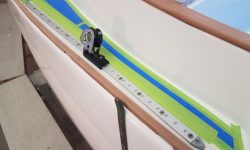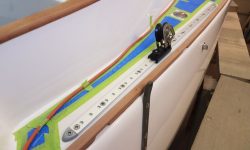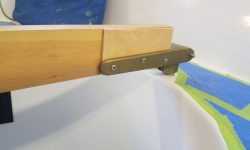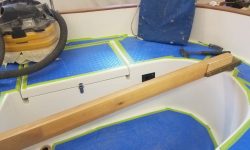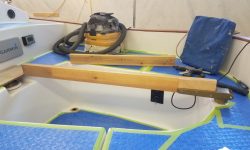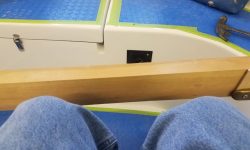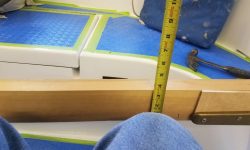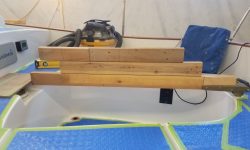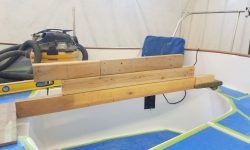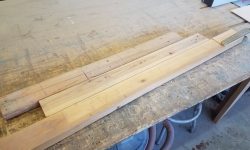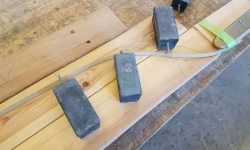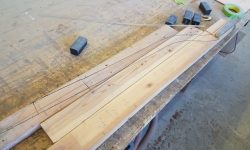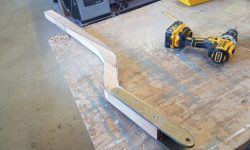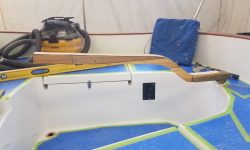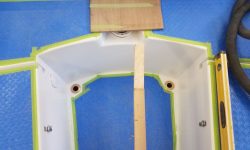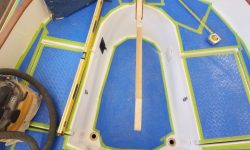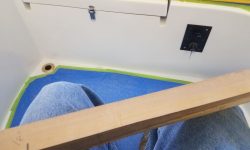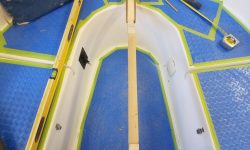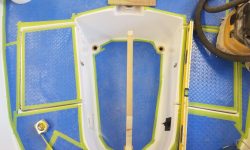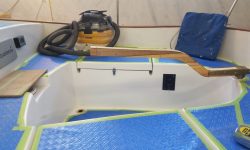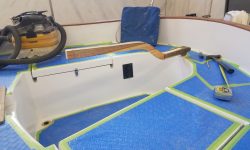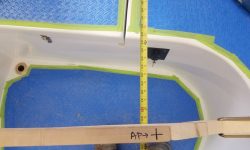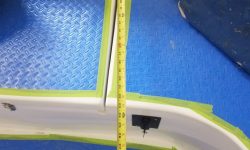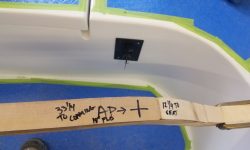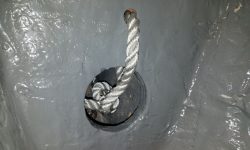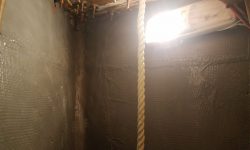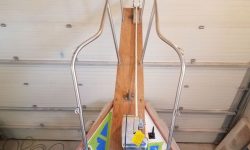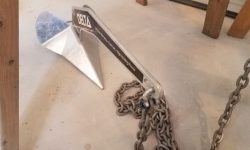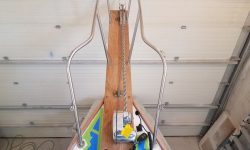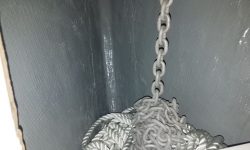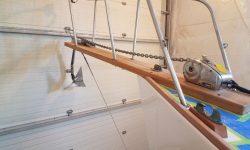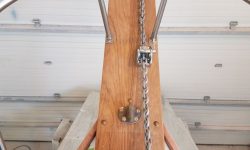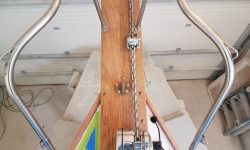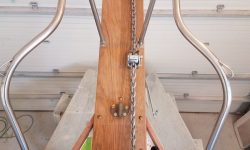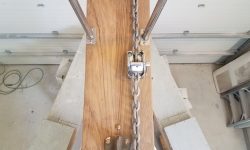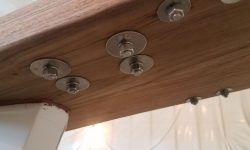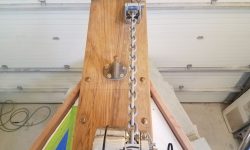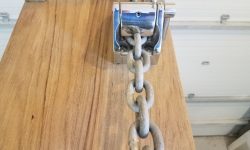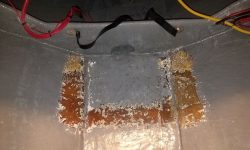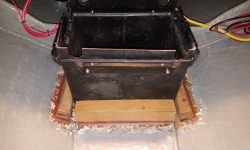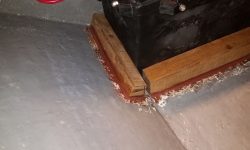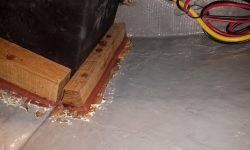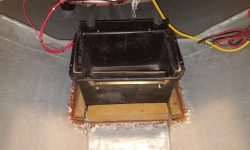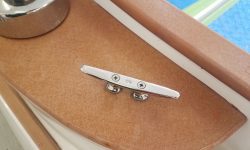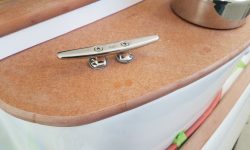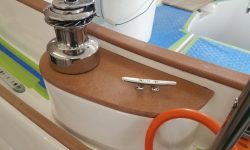February 20, 2020
Scupper 246
Thursday
The new lead cars for the Yankee tracks had arrived, and I took a few moments to install them, and permanently install the after track end stops as well.
One of the small outstanding jobs remaining was to build a tiller, which I’d intentionally put off in favor of working through more of the significant chores, but it was time to start the design process and confirm the shape required for the tiller.
To begin, I screwed a length of scrap 2×4 to the tiller strap (along with a 1/4″ spacer, since the interior of the tiller strap was 1-3/4″ wide), and used this as my initial tiller template. With the “tiller” installed in the cockpit, this gave me a first sense of how the arrangement would work. Obviously the 2×4 was far too low in its initial configuration, given the height and 90° angle of the rudderpost where it exited the cockpit, so it was clear I’d have to add a fairly significant bend to raise the tiller up to a working height. Measuring roughly from my knees in a sitting position, it looked like I’d have to be 6″ higher than the bottom of the initial tiller blank.
I hot-glued one extra layer of 2×4 atop the first, then a second layer when it became obvious I needed the layout space. This clunky-looking template gave me the room to rough out, by eye, a curve from the tiller strap up to the required clearance height, and then figure the shape of the rest of the tiller from there. I struck a level line on the template, as I wanted the reference so I could have the tiller shaped with a few degrees’ up angle versus level.
With the basics in place, I removed the template down to the bench, where I used a flexible curve to lay out what seemed like a reasonable (i.e. do-able) curve for the bottom of the tiller, then copied it 2″ higher to approximate the top of the tiller (or a generous maximum dimension in any event).
Next, I cut out the shape, reattached the tiller strap, and tested the fit and function in the cockpit. The design cleared my knees without raising the tiller at all, though raising it would be easy and natural for additional clearance. Initially I left the tiller over-long, but once it was in place it looked like stopping it 12″ aft of the forward end of the cockpit struck the right balance between cockpit space, and tiller leverage, so I cut the tiller off at that length, with the results seen in the final two photos of this series..
This tiller design (allowing for minor refinements during the final layout and laminating/shaping process) seemed to check all the boxes for form, function, and space, but before wrapping up the initial work for now, I made some measurements related to a possible tillerpilot, based off the documentation of the tillerpilot in which the owner had expressed interest. More on this aspect later as circumstances dictate.
Taking advantage of a bit of time left in the morning session, I loaded the anchor rode–a rope-chain hybrid–on board, starting by leading the bitter end of the rode through the windlass and down into the locker, where I led it below the new anchor shelf and secured it to a hole in the bulkhead below. Then, using the windlass, I loaded all the rode on board and raised the anchor, though with the garage door so close there wasn’t room to get the anchor onto the roller, so I left it hanging for now; it was too cold to open the door just for this purpose, but once it warmed up I could finish loading the anchor (I thought it would clear the door once in place on the roller).
A final installation for the anchor system was a hefty chain stopper, which I located a bit forward of the windlass where it seemed to make sense, yet within easy reach of the foredeck. I secured this with four bolts through the platform.
After review and a discussion, we decided to add some support cleats around the house battery box in the forward cabin, for additional security underway. So with hefty teak cleats already cut to size, I did some early layout around the box, marking the boundaries of the cleats, and then, dismantling for now the batteries and the box to get them out of the way, I sanded away the paint from the hull in way of the new cleats to provide for good epoxy bonding. After final preparations, I secured the wooden cleats around the box with thickened epoxy adhesive, cleaning up the excess and forming fillets on all sides, but leaving the battery box in place while the epoxy cured to hold the cleats and ensure that the box fit properly thereafter.
On the winch islands, I installed a small cleat on each side for spinnaker sheets.
To round out the day, I took care of a couple minor wiring issues, including rewiring the main cabin bulkhead lights to their own circuit breaker, since these lights didn’t have any individual switches on the fixtures themselves, and cleaned up the boat and shop a bit. My focus in the immediate future would be on the engine battery installations–the last significant job ahead, as well as continuing to expunge the various small tasks still remaining on my ever-shortening punch list.
Total time billed on this job today: 7 hours
0600 Weather Observation: -2°, clear. Forecast for the day: Sunny, 20°



